In Water jet Machining no abrasive is used. Water jet alone is used for cutting. In WJM, materials like concrete, asbestos, wood, rocks, coal, textiles and leather can be cut. The material is removed by means of erosion. These days hydraulic coal mining as well as tunneling, descaling and cleaning is also done by this process.
Water Jet Machining (WJM) Principles
As the name suggests the water jet machining process involves the use of high velocity and high pressure thin jets of water to cut the job. Water Jet is the stream of high velocity water coming out from the nozzle. When high pressure water jet comes out of the nozzle it gains a large kinetic energy. After striking the work piece this kinetic energy is converted to pressure energy inducing high stress on the material. When this induced stress surpasses the ultimate stress of the material, removal starts.
Schematic Diagram of WJM
The schematic diagram of WJM process is very similar to that for AJM. To raise the pressure of the water a pump or intensifier is used. The system pressure ranges from 1600 to 4000 N/mm2. The accumulator used in the system act as a pulsation remover and an energy reservoir. Water passes through the accumulator and then nozzle through a high pressure thick tube. The tube material may be stainless steel jacketed with carbon steel. Sintered diamond , sapphire or tungsten carbide may be used as the nozzle material. The exit dia. of the nozzle may vary from 0.05 to 0.35 mm.
 |
| a. Schematic of Water Jet Machining b. Example of workpiece machined by WJM |
Advantages of Water Jet Machining Process
1. Here water is used for cutting which is cheap, non-toxic and readily available.
2. The water jet keeps the job clean and dust free.
3. The only moving part used is the pump, therefore the operating and
maintenance expenses are low.
4. The process is very safe to use.
5. Very complicated designs and detailed work can be done.
6. There is no damage of the workpiece due to thermal stress. Very little heat is
generated.
7. Soft rubber like materials can be cut through this process where saw teeth
gets clogged.
2. The water jet keeps the job clean and dust free.
3. The only moving part used is the pump, therefore the operating and
maintenance expenses are low.
4. The process is very safe to use.
5. Very complicated designs and detailed work can be done.
6. There is no damage of the workpiece due to thermal stress. Very little heat is
generated.
7. Soft rubber like materials can be cut through this process where saw teeth
gets clogged.
Disadvantages of WJM.
1. Hard Materials cannot be cut.
2. The initial cost is high.
Applications:
1. Cutting
2. Milling
3. 3D Shaping
4. Turning
5. Piercing
6. Drilling
7. Polishing
No comments:
Post a Comment